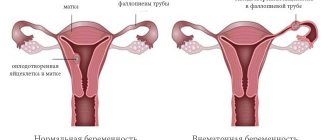Most women try to find out about their pregnancy as early as possible. The reasons for this interest are different for everyone. But curiosity takes over, and they try to quickly acquire special tests. First of all, you need to understand how they work, and then decide when to take a pregnancy test?
How many days later should you take a pregnancy test?
To answer this question, it is important to understand how it works.
Some time after conception, a woman’s body significantly increases the production of the “pregnancy hormone” - hCG (human chorionic gonadotropin)1. The test contains a special substance that reacts to the presence of hCG and colors the strip. Actually, everything is logical and simple: enough hCG in the urine - there will be two stripes. HCG levels do not begin to rise immediately after intercourse. Even when the sperm meets the egg and fertilization occurs, the concentration of the hormone does not change in any way. Therefore, a pregnancy test taken the morning after sex will be negative. The increase in hCG production begins only after the fertilized egg attaches to the wall of the uterus. This occurs 6–10 days after sex and conception2. In the first days, the increase in hCG levels will be insignificant, then everything depends on the sensitivity of the test.
- The most common rapid tests are “tuned” to a sensitivity of 25 mIU/ml. This level of hCG is achieved only a couple of weeks after fertilization, which means that a pregnancy test can be taken 1-2 days after the delay. In the first days, you will need to wait a little while the reaction occurs and the strip turns color. Over the next few days, the concentration of hCG will skyrocket, and most tests will show a positive result almost immediately after entering the urine.
- You can ask your pharmacy for early pregnancy tests. They have a sensitivity of only 10 mIU/ml, thanks to which they are able to show results even before the delay, 3-4 days before the predicted start of the menstrual cycle.
General information
Pregnancy is considered to have occurred when the egg is fertilized and the embryo attaches to the uterine mucosa. Then it develops in accordance with the genetic program. From the moment implantation occurs, the fertilized egg begins to produce the main hormone - human chorionic gonadotropin (hCG). It signals the ovaries that the corpus luteum should continue to synthesize progesterone until the placenta is formed (up to 15 weeks of gestation). In this way, pregnancy is protected from termination, since the excitability and contractility of the uterus are reduced.
The plasma concentration of hCG increases very quickly. At levels around 25 mU/ml during the first week after conception, this hormone doubles every 48 to 72 hours. And the maximum values are recorded at 10–11 weeks of pregnancy, when hCG reaches particularly high levels, up to 280 thousand honey units/ml. First, the hormone appears in the blood (from the 11th day after conception), and a little later it enters the urine (from 12–15 days). These indicators are available for qualitative and quantitative analysis during pregnancy.
What time to take a pregnancy test?
If a woman is “deeply pregnant”, it doesn’t matter what time of day it is done - it will instantly show a positive result. However, at the very beginning of pregnancy, it is necessary to take into account daily fluctuations in hCG levels. The maximum concentration of the hormone is reached in the first half of the day, then falls. This is why a pregnancy test must be done in the morning. During the day and evening, you may get a false result due to a drop in the hCG content in the urine.
Another factor that can ruin the test is urine that is too “diluted.” You shouldn’t put too much work on your kidneys, i.e. Drink plenty of fluids or take diuretics before the test.
Optimal time to determine pregnancy
Pregnancy beautifies any woman. Signs appear in the body and appearance of the expectant mother that make it possible to understand that the woman is in an interesting position. And modern medicine does not stand aside; with the help of special testing, ultrasound or blood tests, you can understand that a woman will soon become a mother.
First of all, a woman notices the absence of menstruation at the usual time. You can even take a special test for the hCG hormone on the first day of the delay, which allows you to find out up to 10 days from the start of conception that a new life has arisen in the woman’s body. You should not take such tests before the delay occurs; the result may not be accurate.
Ultrasound examination using the abdominal or transvaginal method will help confirm pregnancy at a short term The latter option can determine the presence of a fertilized egg in the third week of pregnancy, however, it is not yet possible to find out about the presence of an embryo there. It will be possible to see the embryo only in the 5th week of the term, at which time the external ultrasound method will be able to detect pregnancy.
In addition, in the absence of menstruation, a woman can independently determine whether she is pregnant if she starts measuring her basal temperature. Indicators above 37C° observed for two to three days indicate a positive result. This method will appeal to those who regularly keep a calendar of such measurements.
Within a few days after possible conception, many women begin to feel some ailments :
- Dizziness;
- Nausea;
- Weakness;
- Headache;
- Irritability.
These are signs of hormonal changes during pregnancy. Some women may experience slight bleeding, indicating that the fertilized egg is attached to the walls of the uterus.
Advertisement
Often, when pregnancy occurs, the expectant mother feels tension in her chest, some feel pain, and pigmentation appears in the nipple area. In addition, there may be changes in tastes; some people want salty, while others prefer sour. Such taste changes are explained by early toxicosis .
However, despite the existing jokes about pickles with jam, not every woman in an interesting position feels the need to experiment with different products. Changes in appetite occur more often, from complete aversion to food at the very beginning of pregnancy to uncontrollable appetite throughout the entire period of gestation. All these signs are very individual, and one should not judge anything based on their presence or absence.
The picture is completed by small rashes on the woman’s skin, pigmentation on the face and constant drowsiness . In other words, a woman’s condition may change dramatically or not change at all, and only a growing belly can remind her of pregnancy.
All the signs described above can tell a woman about a new life that has arisen in her even before the onset of a missed period.
What types of pregnancy tests are there?
They all work on the principle of determining the concentration of hCG in urine - there are no other options. As we have already said, they differ in what day the pregnancy test is taken, i.e. sensitivity. In addition, they have differences in design. Let's look at what types are available for sale.
Strip test Test cassette Inkjet test Electronic test
- This is the simplest option, which is a strip of paper with a mark applied, to which it must be immersed in a container with urine. The advantages of the strip test include the fact that it is the cheapest of all, the disadvantages are the need to aim at the jar and a complex usage pattern compared to others. The strip must be immersed in urine strictly to a certain level and kept in it no less and no more than the time specified in the instructions. A minimal error can lead to a false result3.
- Cassettes (sometimes called “plate tests”) are strip tests in convenient packaging. When conducting such a study, a jar is not used, and nothing needs to be immersed anywhere. It comes with a pipette, from which you need to drop a couple of drops of urine into a special window and wait for the result. Despite the fact that there is a regular test strip inside the cassette, this scheme of action significantly reduces the likelihood of error.
- As the name implies, the test must be placed under a stream of urine. This is its main advantage: due to the fact that it does not require any auxiliary devices, it is very easy to use. However, you always have to pay more for convenience: the disadvantages of the method include a higher price.
- An electronic test is the highest level of comfort in determining pregnancy. Like the jet one, it needs to be placed under a stream of urine, but you don’t have to look closely at the stripes. The test itself will write “pregnant” or “not pregnant” on the screen. Some models can even show how many weeks have passed since conception - just like a real laboratory study. This method, perhaps, has almost no disadvantages, if you do not take into account the highest cost of all.
There is hope! Several BUTs...or can the test be negative BUT you are pregnant?
- The test may give a false result even a week after the delay. If you still suspect pregnancy, be sure to visit a gynecologist.
- If you are taking certain medications that contain the hCG hormone, they may also affect the accuracy of the result.
- And, of course, you should not smoke, drink or take drugs. They will affect not only the results of the pregnancy test, but also your health and the health of your unborn baby.
And finally, Mikrusha offers you the most popular pregnancy tests:
Pregnancy tests FRAUTEST: express, doublecontrol, expert, frautestcomfort, exclusive.
CLEARBLUE Pregnancy Test: Clearblue Litmus Stick Test and Clearblue Digital Test.
EVITEST pregnancy test: EVITEST One (pregnancy test), EVITEST Plus (2 test strips), EVITEST Proof (plate test - cassette with pipette), EVITEST Perfect (inkjet test cassette with holder and cap).
There are also pregnancy tests BABYCHECK, LADY TEST, MON AMI, LADY CONTROL, Rest assured and others.
How to take a pregnancy test correctly?
You will find exact information about this in the instructions for the express test; each of them may be slightly different. When carried out correctly, they provide a very high level of reliability - almost the same as testing blood in a laboratory3. In most cases, the wrong result is obtained due to trivial errors, and here are the most common ones:
- The test was done too early. Doing it immediately after conception is completely pointless. Tests with standard sensitivity work starting from the first day of the delay, more accurate ones - 3-4 days before.
- The test was carried out in the afternoon or evening. At the beginning of pregnancy, when the concentration of hCG during the day may become too low, it should be done in the morning.
- There is a lot of water in the urine. Don't drink a lot of fluids the night before the test and don't take diuretics.
- The expiration date has expired. If the test is expired, it may give a false negative result. Be sure to check the expiration date before use.
There are other factors that can cause an incorrect result, such as ectopic pregnancy, tumors and other diseases4. Therefore, remember: a pregnancy test is not the ultimate truth, but just a reason to see your doctor. Only he can finally confirm that the joyful event has happened!
- Cole LA (2009). "New discoveries on the biology and detection of human chorionic gonadotropin". Reprod. Biol. Endocrinol. 7: 8. Link: https://www.ncbi.nlm.nih.gov/pmc/articles/PMC2649930/
- Wilcox AJ, Baird DD, Weinberg CR (1999). "Time of implantation of the Conceptus and loss of pregnancy." New England Journal of Medicine. 340(23):1796–1799. Link: https://www.nejm.org/doi/full/10.1056/NEJM199906103402304
- Bastian LA, Nanda K, Hasselblad V, Simel DL (1998). Diagnostic effectiveness of home pregnancy test kits. A meta-analysis. Arch Fam Med. 7 (5): 465–9. Link:: https://www.ncbi.nlm.nih.gov/pubmed/9755740
- Stenman, Ulf-Håkan; Alfthan, Henrik; Hotakainen, Kristina (July 2004). "Human chorionic gonadotropin in cancer." Clinical Biochemistry. 37(7):549–561. Link: https://www.sciencedirect.com/science/article/pii/S0009912004001274?via%3Dihub











